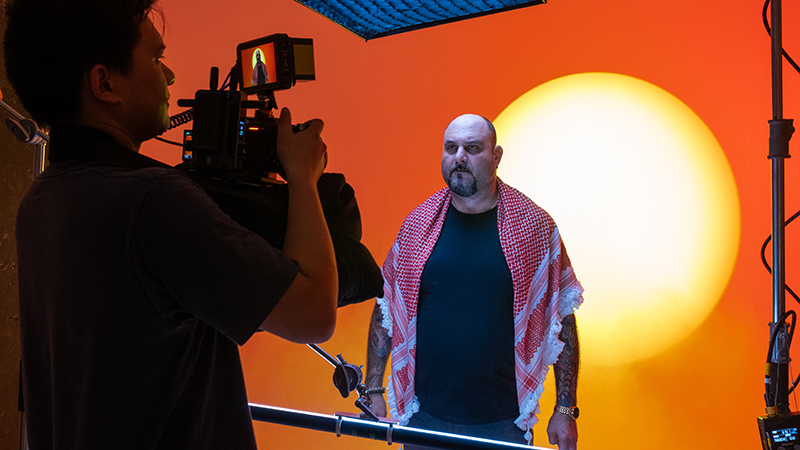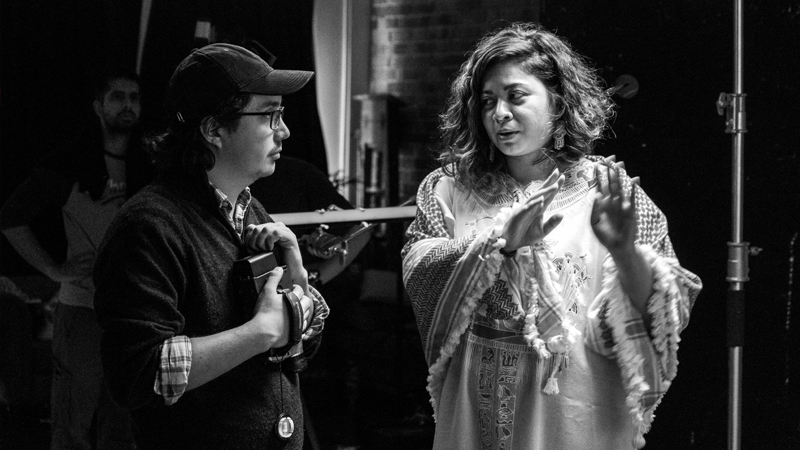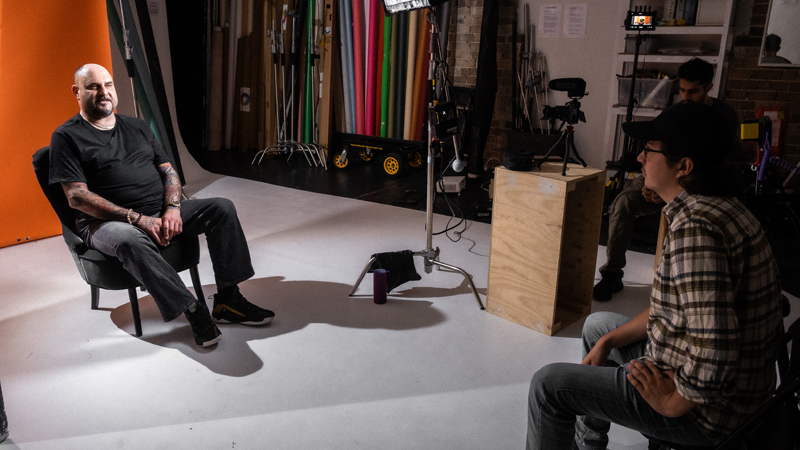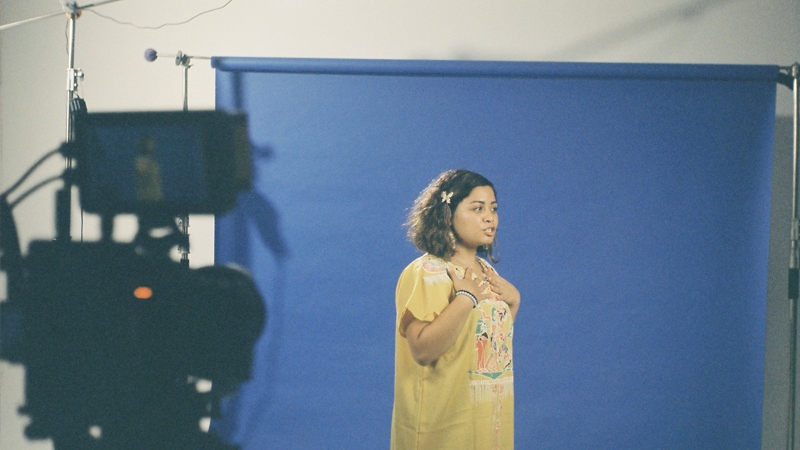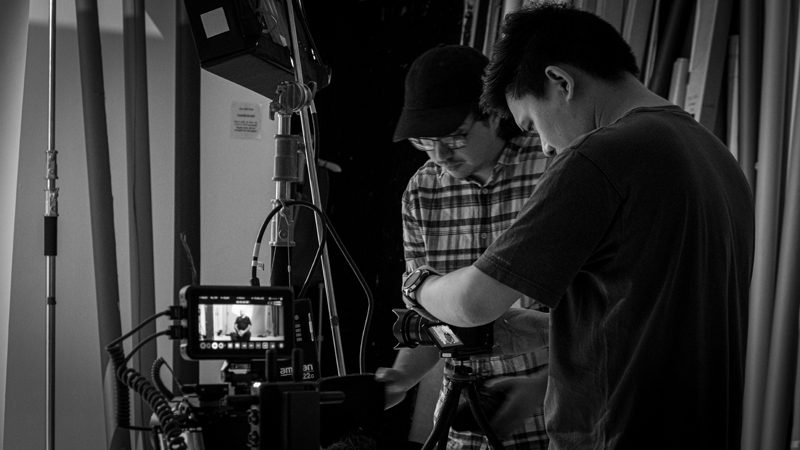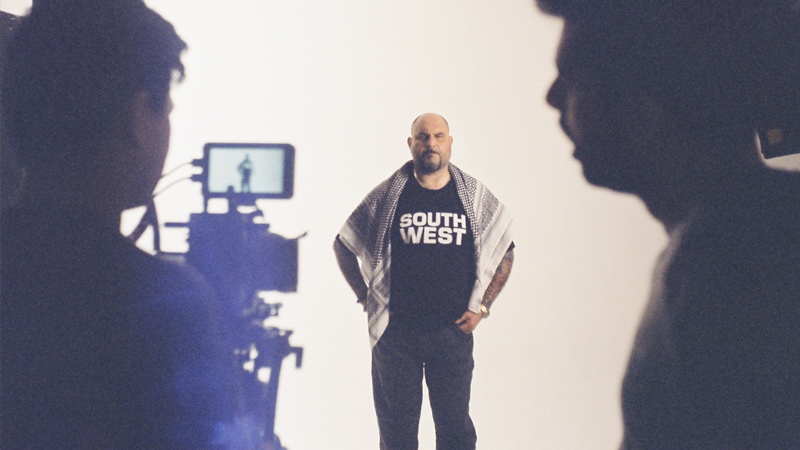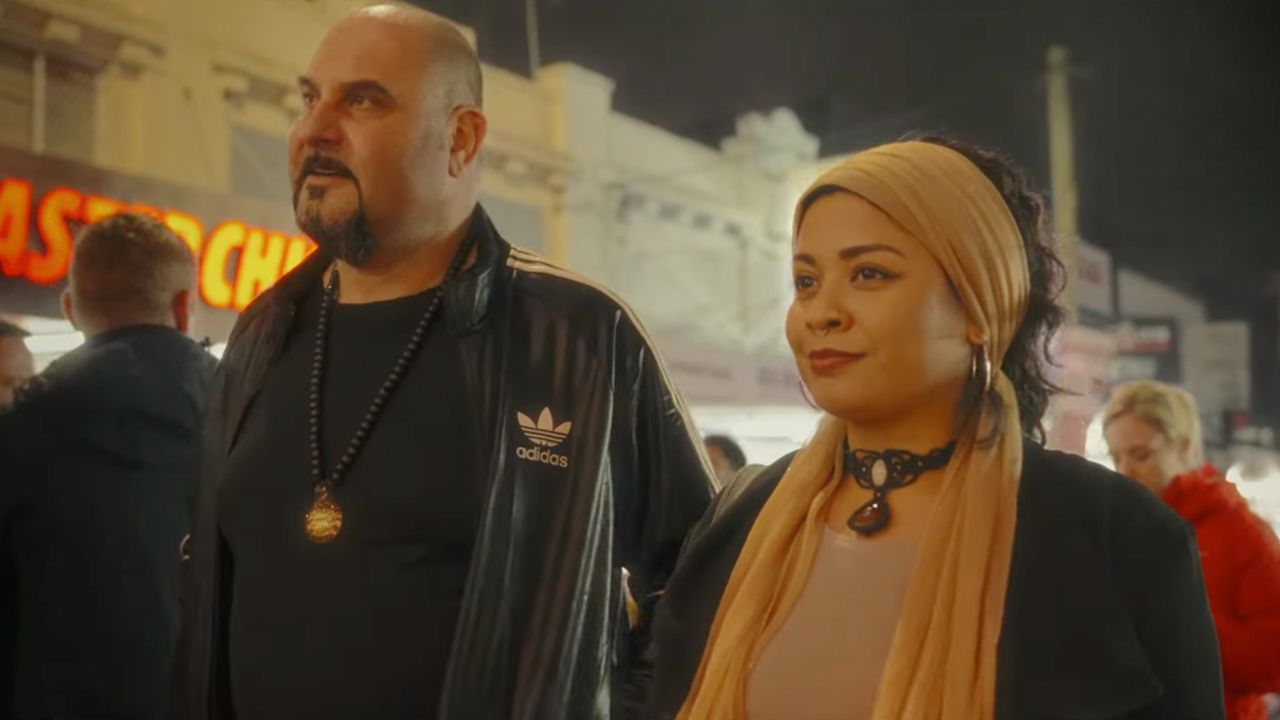
FEATURE: South West Syndicate – The Voyage (Dir. Cristobal Olguin)
Australia is built on stories. However, the ones we prop up tend to reflect a far more milquetoast experience. Packed to the brim with backyard barbies, beers with mates and blonde surfer dudes, there seems to be little to no room for the real lives that make up our cultural melting pot – whether it’s First Nations people and their rich history, or hard working migrant families. That’s why Lebanese born Australian rapper, Nasri ‘Big Naz’ Bassal created The Voyage; a tribute to his father, and the “many migrants who [came] to Australia…[before him.]” Opening the song with a short monologue from Naz’s own father, Tommy, the listener is given a second-hand account of the verbal abuse he experienced on a daily basis. Underscored by the soulful vocals of Zeadala, his words are given a sermonic weight. And while Naz listens on, eyes closed and warming up to his first verse, director Cristobal Olguin splices in childhood photos of Naz and his parents. Before he utters a single line, Naz suggests to the listener that the racism his father experienced is not only something he grew up hearing, but something he has had to contend with in his own lifetime. Olguin weaves archival photos to not only bolster Naz’s message, but to bring the audience into the rapper’s world. Olguin elaborates further, saying:
“After a thorough process, we chose to center our visuals on Big Naz, his father Tommy Bassal, and their family’s immigration journey to Australia […Using] archival photos and current-day VHS footage [, we set out]…to humanize the migrant experience. Immersing ourselves in Big Naz’s family life for the video, we effectively portrayed their journey…The story of migration is not limited to just the past and one family’s experience. The story of migration in Australia is also the story of escaping conflict, oppression, escaping political and economic colonisation, and it’s an ongoing narrative that will continue in Australia. These narratives will continue to shape our future. These stories are crucial to recount, showcasing the resilience, challenges, and contributions of past, present, and future migrants in Australia.”
- BTS by Tobias Tarasov of Big Naz addressing the camera.
With South West Syndicate being a hip-hop collective representing BIPOC artists, it was important to Olguin that he directly collaborate with Naz and Zeadala on the project. Balancing an interview, a spoken word monologue and several verses of rap and soul are not too challenging when it comes to music alone. With endless sonic possibilities on a relatively tight budget, you can achieve anything. Yet Olguin admits he struggled in translating The Voyage’s eclectic vision to the screen:
“I first met the team through Zeadala [when I] worked with her on a previous music video… Big Naz and her were [both] quite flexible and collaborative regarding the best approach for the music video. Planning the concept …took some time and involved a lot of pivoting. The song goes in different stylistic directions, and both artists have unique expressions to their performances, making it tricky to settle on one central idea. Initially, we considered incorporating dancers from various cultures, but we were concerned about potential stylistic clashes that might not fit well with the overall tone of the song.”
- BTS by Tobias Tarasov of Director Cristobal Olguin and Zeadala collaborating on a shot.
To pull the project into focus, the team had to quite literally go back to their roots. This involved revisiting many locations from Naz’s childhood like his family home and the local night markets. As cinematographer Andrew Lin pans and whips across Naz and Zeadala, they peruse the local Lakemba Market’s in Sydney’s southwest. This bombastic sequence and its accompanying shoot informed a great deal of the video’s style. Olguin uses the group’s over thirty year experience in the rap game to his advantage, harkening back to the good ol’ days of 90’s hip-hop. Like Biggie Smalls placing himself on the steps of a Brooklyn apartment in Juicy, Zeadala and Naz use the setting as a way of referencing their roots and the community they continue to be a part of.
“Our first day of filming was at the Lakemba markets during Ramadan in 2023. At that point, we were unsure what the final video would look like, so we followed Zee and Naz into different shops, visited different venues, and filmed throughout the night in a pure documentary style. This approach led us to discover interesting visuals that shaped [Voyage’s] style. For instance, the street…shots – where Big Naz and Zeadala were under…strong red and purple lights – were found by chance during Lakemba nights. Those lights [were] already set up for the event, [so we] filmed our performance shots there.”
- BTS by Tobias Tarasov of Director Cristobal Olguin and Big Naz speaking through their process.
Choosing to shoot “guerrilla-style” during Ramadan gives this section of the music video – and the place itself – an almost spiritual quality. Once again, tying into the theme of immigrant pasts reemerging – this time, as a current day mythos. In one mesmerising shot, Zeadala is bathed under purple light and her stare into the camera gives off a sort of holy glow. Meanwhile Naz spitting rhymes in the middle of the market reminds the listener of a philosopher regaling his truth in the modern day Agora. Hoping to adapt the ethereal nature of the market’s lights to some of his shots in the studio, Lin used a surprisingly simple set-up:
“We used the FX3 and the Sigma 24-70mm to film the music video. For lighting, we originally planned on having a mono-colour projector light to add shapes to the backdrop that was being lit by RGB light mats. The mono-colour projector didn’t really give us the effect we wanted, so we actually rented an RGB projector light, which really allowed us to dial in the specific colours that contrasted the background. This visually emphasised Zeadala’s already powerful performance and took it to another level.”
- BTS by Tobias Tarasov of Zeadala in front of a blue screen.
The last piece of the puzzle for Olguin was finding a way to incorporate Naz’s family into the music video. After all, The Voyage ultimately retells the stories of Naz’s parents, so it naturally seemed pertinent to have them involved in the creative process alongside their son. It’s evident through the VHS footage of Naz reminiscing over a scrapbook with his Mum or Dad at the dining table, as they pore over old polaroids, that there is power in the home video format to stir one’s sense of empathy. Despite being a recreation as opposed to the real archival photos, it’s difficult not to feel a level of nostalgia as we watch Naz and his family through the static-tinted glasses of an old camcorder. Even behind the camera, Olguin found himself taken back by the whole experience, saying of his time at the Naz family home:
“During our brainstorm[ing] session for the music video, Big Naz told us about his father, and their family’s journey, which he incorporated into the storytelling of the song. It made a lot of sense to blend styles, capturing Big Naz’s performance while documenting their interaction; glimpsing into the past through archive photos. On the day of filming, Andrew, Zeadala, and I were invited to [Tommy’s] home for lunch, where we spent time talking about their experiences arriving in Australia, the challenges they faced, and even the traditional food they continue to embrace.”
- BTS of Director Cristobal Olguin and DOP Andrew Lin getting in position for a take.
For their own part, Naz and Zeadala were adamant about acknowledging the people of Palestine and Naz’s home country of Lebanon. The pair can each be seen with a keffiyeh, a traditional form of head dress worn by Arab citizens, draped over their shoulders. Specifically, they wear the Palestinian keffiyeh as a way of showing solidarity with those who continue to be systematically displaced and killed by Israel. Notably, it was used by early Jewish migrants during the Palestine Mandate by the League of Nations. Seen as nothing more than a fashionable item of clothing, settlers were not only complicit in colonising Palestinian culture, they were more than happy to appropriate it. It wasn’t until the 1960’s, however, when Yasser Arafat began to lead Palestine, that the headwear was reclaimed as a symbol of resistance by the Palestinian people. Naz and Zeadala tie Australia and Palestine together with one show of solidarity, suggesting that they and other migrants share the pain of colonisation.
“[Since] the settlement of the Jewish state in Palestine this issue has crept into Lebanon like a flow on effect and caused unrest. Many families like my own have felt unsafe and have had to leave Lebanon due to the hostile environment.” – (Big Naz).
“The role of an artist is to reflect the times and at this present moment, we as a collective are baring witness to a horrifying genocide and ethnic cleansing of our Arab brothers and sisters…[by] Israel. While our own government remains complicit in aiding [them] with the [killing and displacing] of over 45,000 people, we artists are continually silenced for condemning this injustice and violation of human rights. The keffiyeh speaks volumes about resistance in the face of colonisation. We are largely migrants here in Australia because our lands have also been colonised by the west and so we show solidarity with our siblings through speaking up, spreading awareness and celebrating their rich culture until Palestine is free from the river to the sea.” – (Zeadala)
- BTS by Tobias Tarasov of Big Naz wearing a keffiyeh & a South West tee looking to the camera.
The Voyage, and Olguin’s accompanying music video, beautifully distil what South West Syndicate have been advocating for over thirty years: that real Australian culture is diverse, not diluted, and that a fierce call to acknowledge all our stories is needed for us to move forward as a nation. Their new album “The Promised Land” offers a hopeful message: if you’re being silenced, the best way to be heard is to scream, shout and make some noise.
Here is the official video for “The Voyage” ft. Tommy Bassal & Zeadala
Music Video Credits
Director & Post-Production: Cristobal Olguin. DOP & Gaffer: Andrew Lin. Lighting Assistant & BTS: Tobias Tarasov. Lighting Assistant: Kern Sharma.


